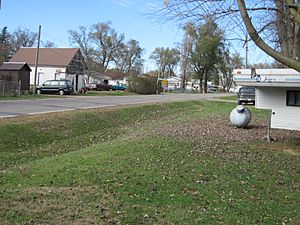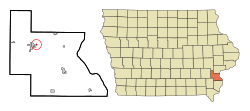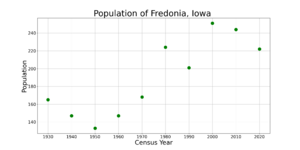Fredonia, Iowa facts for kids
Quick facts for kids
Fredonia, Iowa
|
|
|---|---|
 |
|

Location of Fredonia, Iowa
|
|
| Country | |
| State | |
| County | Louisa |
| Area | |
| • Total | 0.15 sq mi (0.39 km2) |
| • Land | 0.15 sq mi (0.39 km2) |
| • Water | 0.00 sq mi (0.00 km2) |
| Elevation | 594 ft (181 m) |
| Population
(2020)
|
|
| • Total | 222 |
| • Density | 1,470.20/sq mi (569.34/km2) |
| Time zone | UTC-6 (Central (CST)) |
| • Summer (DST) | UTC-5 (CDT) |
| ZIP code |
52738
|
| Area code(s) | 319 |
| FIPS code | 19-29055 |
| GNIS feature ID | 0456753 |
| Website | fredoniaiowa.gov |
Fredonia is a small city in Louisa County, Iowa, United States. It is located in the eastern part of Iowa. In 2020, about 222 people lived there. Fredonia is part of the larger Muscatine area.
Contents
History of Fredonia
Fredonia was first planned out in 1836. A man named Alvin Clark, who lived on the land, helped to set up the town. John Gilliland helped to survey the area.
The city is located on the east side of the Iowa River. It is just below where the Iowa River meets the Cedar River. Alvin Clark and his brother Gibbs are thought to be the first people to settle in Fredonia.
Fredonia is one of the oldest towns in Iowa that has continuously been a city. There's a story that Fredonia almost became the capital of Iowa. However, this idea was not seriously considered by lawmakers at the time. Many other towns were also suggested for the capital.
Geography of Fredonia
Fredonia is located in a special spot. It is just east of where the Iowa River and the Cedar River join together. The town of Columbus Junction is nearby, just across the Iowa River to the southwest.
The United States Census Bureau says that Fredonia covers about 0.17 square miles (0.44 square kilometers). All of this area is land.
Population of Fredonia
| Historical populations | ||
|---|---|---|
| Year | Pop. | ±% |
| 1930 | 165 | — |
| 1940 | 147 | −10.9% |
| 1950 | 133 | −9.5% |
| 1960 | 147 | +10.5% |
| 1970 | 168 | +14.3% |
| 1980 | 224 | +33.3% |
| 1990 | 201 | −10.3% |
| 2000 | 251 | +24.9% |
| 2010 | 244 | −2.8% |
| 2020 | 222 | −9.0% |
| Source: and Iowa Data Center Source: |
||
The population of Fredonia has changed over the years. In 1930, there were 165 people. The population grew to 251 people by 2000. By 2020, the population was 222 people.
Who Lives in Fredonia?
In 2020, there were 222 people living in Fredonia. These people lived in 80 households. A household is a group of people living together in one home.
- About 42.5% of households had children under 18.
- Many households were married couples living together.
- Some households were single-parent families or individuals living alone.
The people in Fredonia come from many different backgrounds. In 2020, about 56.3% of the people were White. About 14.9% were Asian, and 20.3% were from other races. Also, 36.0% of the population was Hispanic or Latino.
The average age in Fredonia in 2020 was 38.8 years old.
- About 30.6% of residents were under 20 years old.
- About 12.2% were 65 years old or older.
- The city had slightly more males (53.2%) than females (46.8%).
See also
 In Spanish: Fredonia (Iowa) para niños
In Spanish: Fredonia (Iowa) para niños


